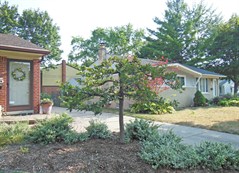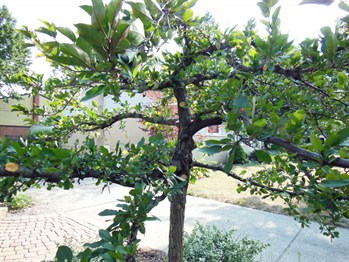Curing a dwarf that's too big and too shaggy
This page Sponsored by:
The Sargent crabapple is a very fine tree. It has fragrant
flowers (pink in bud, open white), tiny bright red fruit that hangs
on through winter to delight the eye and fruit-eating birds, great
disease resistance and a beautiful low, wide-spreading form. Yet
even a compact tree like this can overstep its bounds, and in its
fullness be transformed from well branched sculpture to ordinary
chubbiness.
We took this tree in hand on one late summer evening.
Late summer is a good time to prune to both
restrict the size and direct the shape.
- Size-wise: Remove some foliage before the growing season winds
down to cut the plant's energy production. That can reduce the
growth without robbing the tree of the vigor it needs to have
something 'in the bank' as a hedge against possible tough
times.
- Regarding shape: Create a shape now and it tends to last since
the tree has stopped extending its branches and begun hardening its
new wood. It won't respond by developing clusters of new shoots
from every cut stub. The buds we choose to leave at the branch tips
will take on the role of lead bud as they ready for winter. The
growth will not be wild next spring but head in the direction we've
"pointed" with those buds.
Below: Left, the starting point. Center, cut to remove
excess main branches. Right, main branches shortened, pruning's all
done. (Want to see these images
larger?)



This crabapple is the focal point at the front door garden. If
it reaches its type's normal size of about 8 feet tall and half
again as wide, it will overhang the walk and obstruct the driveway.
So it must be kept this size.
Marilyn, the gardener-owner, has been doing that but saw the
shape was becoming "a blob" and asked us in to show her how-to.
Janet and Deb Hall do the teaching while Marilyn and others learn
by doing. (You can come learn at a Garden By Janet &
Steven session, too!)
First we determine which of its too-many main limbs should stay.
Look up into a tree from underneath, as we looked up into this one
-- see the photos at the top of this page and also below. Identify
branches that are distributed around the trunk and from low to
high, so each can grow foliage into its own bit of sky without
competing and stretching to get out of the shade of other
limbs.


Above: Pruning by committee takes extra time, as everyone
looks and then discusses which branches she wants to remove.
Marilyn watches as Deb selects; then Marilyn takes her own
look.



Here is what we started with, and a second look after thinning.
In removing these limbs we cut close to the trunk but preserved
the branch bark collar.

Next we shorten each of the main limbs we've kept. We cut each
one back to a well-placed side branch that can take the lead and
grow for a year or two without crossing the line to make the tree
too big.
That's it.
Now we can let the tree go for two years.
Did we remove a lot of the foliage and wood? More than the "1/3
rule"? Yes, but we're playing catch-up to take away what had
built up over 10 years. In addition, we're cutting at a time when
the loss will not rob the tree or stimulate it to grow crazily --
the two considerations behind the 1/3 rule.
Can we see through the tree? Yes.
Right: We can see right through to the people who came to
learn, as they admire their work. We couldn't have seen them when
we started!
If you were growing this tree as a hedge (a great choice) you
might not want to prune it this way.
Do we lose flower? Yes, in that every branch we took out that
was over two years old is not going to be there to flower in
spring! However, the branches we left in place will bear flowers
and fruit.
One last thing, now.
We see suckers (blue arrow in the photo above). That's common on
crabapples, which are grafted to roots of different types of apple.
Those roots often are more vigorous than the desirable tree, and
develop suckers. Let's cut them out.
Below: We trowel away soil from above the roots and between
the suckers to see where each sucker arises from a root (white
arrow). See these shoots have developed their own roots above the
main root system? They are becoming independent trees. If we simply
cut them at ground level, especially if we do that in spring, each
cut produces two or three shoots. Then, one sucker becomes three
and the tangle around the trunk becomes totally unmanageable.
Instead, we cut each off of the root that developed it. (Removing
one with sawaw, at right in thenhoto.)

Sponsored by Ray
Wiegand's Nursery

You can become a Sponsor...
More Sponsor recommended
pages...